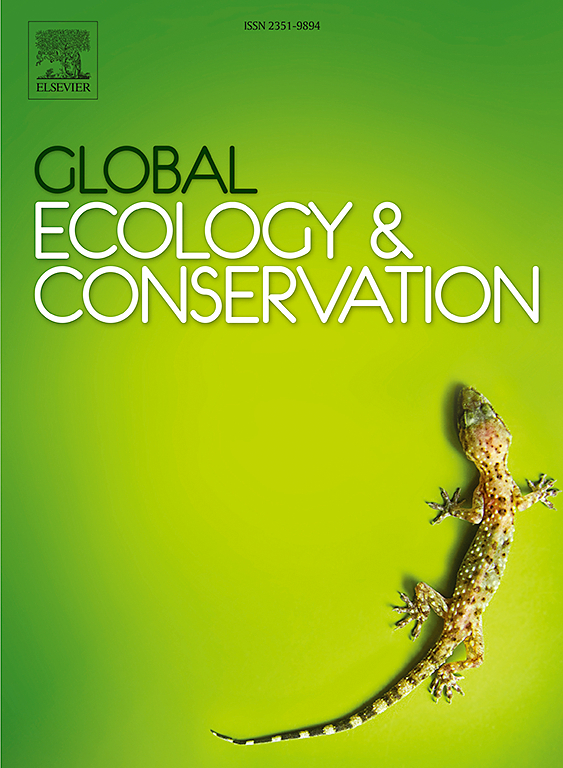碧眼龟的微生境选择及其保护意义
IF 3.5
2区 环境科学与生态学
Q1 BIODIVERSITY CONSERVATION
引用次数: 0
摘要
了解极度濒危的Beale’s eyed turtle (Sacalia bealei)的微栖息地偏好对其保护至关重要。采用无线电遥测和样方抽样的方法,研究了虎伯寮自然保护区不同繁殖期(4 - 6月、11月)和非繁殖期(7 - 10月)的生境选择模式。通过对比使用样方和对照样方,我们确定了生境选择的关键生态驱动因素。研究结果表明,山梨偏爱深溪池、石洞丰富、果实丰度高、底栖生物多样性和丰度高的生境。生境利用的季节变化明显,繁殖生境以木本植物密度低、凋落叶薄、海拔高、石洞可利用性高为特征。为了验证这些模式,我们应用随机森林和LASSO回归模型,证实隐蔽性和资源相关因子是生境选择的最强预测因子。两种模型的分类准确率都很高(Random Forest: 86.11 %;LASSO: 88.89 %)增强了我们研究结果的稳健性。这些结果表明,由于其依赖于特定的微生境条件,因此易受生境破碎化和人为干扰的影响。我们提出了有针对性的保护策略,包括河岸植被恢复、人工庇护所建设和基于社区的反偷猎倡议,以减轻威胁。这项研究对保护这一极度濒危物种具有重要意义,不仅为保护海龟提供了重要的见解,而且为全球海龟和陆龟保护工作做出了贡献。通过填补研究中的一个关键空白,我们的工作为全世界同类物种的保护提供了有价值的指导。本文章由计算机程序翻译,如有差异,请以英文原文为准。
Microhabitat selection by the Beale’s eyed turtle (Sacalia bealei) and conservation implications
Understanding the microhabitat preferences of the critically endangered Beale’s eyed turtle (Sacalia bealei) is essential for its conservation. We investigated habitat selection patterns across breeding (April–June, November) and non-breeding (July–October) seasons in the Huboliao National Nature Reserve, China, using radio telemetry and quadrat sampling. By comparing used and control quadrats, we identified key ecological drivers of habitat choice. Our findings revealed that S. bealei prefers habitats with deep stream pools, abundant stone caves, greater fruit abundance, and high benthic species diversity and abundance. Seasonal variations in habitat use were evident, with breeding habitats characterized by lower woody plant density, thinner leaf litter, higher elevations, and increased stone cave availability. To validate these patterns, we applied the Random Forest and LASSO regression models, which confirmed that concealment and resource-related factors were the strongest predictors of habitat selection. The high classification accuracy of both models (Random Forest: 86.11 %; LASSO: 88.89 %) reinforced the robustness of our findings. These results underscore the vulnerability of S. bealei to habitat fragmentation and human disturbance, given its reliance on specific microhabitat conditions. We propose targeted conservation strategies, including riparian vegetation restoration, artificial shelter creation, and community-based anti-poaching initiatives, to mitigate threats. This study has significant implications for the conservation of this critically endangered species, providing vital insights not only for its protection but also contributing to global efforts in turtle and tortoise conservation. By filling a key gap in research, our work offers valuable guidance for the conservation of similar species worldwide.
求助全文
通过发布文献求助,成功后即可免费获取论文全文。
去求助
来源期刊

Global Ecology and Conservation
Agricultural and Biological Sciences-Ecology, Evolution, Behavior and Systematics
CiteScore
8.10
自引率
5.00%
发文量
346
审稿时长
83 days
期刊介绍:
Global Ecology and Conservation is a peer-reviewed, open-access journal covering all sub-disciplines of ecological and conservation science: from theory to practice, from molecules to ecosystems, from regional to global. The fields covered include: organismal, population, community, and ecosystem ecology; physiological, evolutionary, and behavioral ecology; and conservation science.
 求助内容:
求助内容: 应助结果提醒方式:
应助结果提醒方式:


